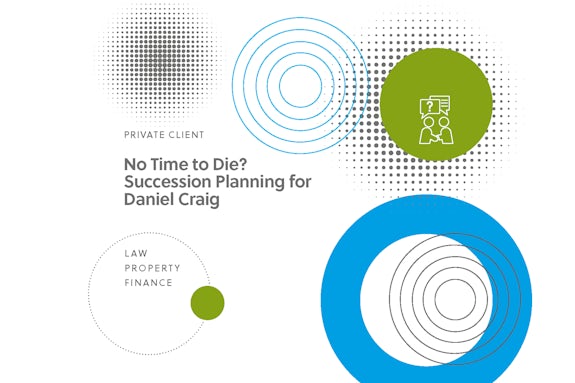James Bond actor Daniel Craig recently made headlines for revealing that he will not leave his children a substantial inheritance and would prefer to “get rid of it or give it away” before he goes.
While the inheritance practices of Hollywood actors may seem a world away, the move by Craig raises some interesting considerations for anyone considering succession planning in Scotland.
The three most common considerations to weigh up are:
- Legal Rights;
- Inheritance Tax planning; and
- Leaving your estate to charity
Legal Rights
The concept of Legal Rights applies to estates in Scotland to ensure that no child (or indeed the spouse or civil partner) of a deceased person can be disinherited. You may be under the impression that if provision is not made for a child or spouse in your will, they are entitled to nothing. This however is not true.
Where a person dies domiciled in Scotland survived by children and a spouse or civil partner, the surviving spouse or civil partner is entitled to one third of the deceased’s moveable estate, with the deceased’s children being entitled to one third collectively.
If there is no surviving spouse or civil partner, this share which can be claimed by children would increase to one half of the moveable estate. This would also apply vice versa if there was a surviving spouse or civil partner but no children.
It is worth noting that the term ‘moveable estate’ is used to describe all of the deceased’s assets aside from any land and buildings (except those used in a business). As such, moveable estate would include cash, bank accounts, shares and personal possessions to name but a few.
In Daniel Craig’s case, he has two daughters (one with his current wife and one from a previous marriage) and a step-son. If Daniel Craig was based in Scotland, his wife would be entitled to one third of his moveable estate, with his two daughters entitled to one third collectively, or one sixth each. Currently step children have no rights to a step parent’s estate.
As such, regardless of what Craig’s intentions are for his inheritance or what his will says, his wife and two daughters would be entitled to a sizeable claim on his moveable estate per their Legal Rights, although they could not claim those rights and take any entitlement under the will. Unless the law changes Legal Rights cannot be defeated but there are some practical steps which can be considered, such as moving moveable assets out of your estate (in ways such as are described below, perhaps) or having the claims discharged by the potential recipients.
Inheritance Tax planning
On the other hand, one area that Craig’s “get rid of it or give it away before you go” belief may prove astute is in minimising his estate’s Inheritance Tax (IHT) liability.
As a rule of thumb, all UK taxpayers are entitled to a tax free allowance of £325,000, known as a ‘nil rate band’. Any portion of the estate thereafter is taxed at 40%, although this can be reduced by donating a proportion of your estate to charities, something we will look at in detail below.
Further exemptions can be used alongside the nil rate band, including:
- Any unused nil-rate band can be transferred to your spouse or civil partner, meaning that couples can benefit from £650,000 of nil rate band;
- An additional ‘residential’ nil rate band of £175,000 also exists when passing on your family home to your direct descendants (i.e. a child).
While these exemptions can reduce your IHT liability greatly, they only go so far, and individuals with sizeable estates like Daniel Craig can find their estate still saddled with a large IHT bill.
As such, it makes increasing sense to look at IHT planning as an ongoing process through your life, and not an issue to be addressed once you have died.
If you are looking at minimising your potential IHT liability during your lifetime, two popular options are (I) setting up a trust and (II) lifetime gifts.
Setting up a trust
Setting up a trust, transferring assets into it and ultimately out of your estate, allows you to leave the asset for the benefit of your chosen beneficiaries, whilst reducing your IHT liability and retaining control as a trustee in determining when it should be paid out, i.e. when a beneficiary reaches a certain age.
Once the creator of the trust passes away, ownership and control of the trust passes to your nominated trustees, highlighting the need to appoint trustees you have faith in.
It should be pointed out that trusts are not exempt from IHT, and depending on the value of the assets within the trust, there can be IHT payable when;
- The trust is set up;
- When assets are either taken out of the trust; or
- The trust is closed down permanently;
Furthermore, the assets within a trust must be valued every 10 years, with the value of the trust over the nil rate band of £325,000 liable for IHT at 6%.
As such, transferring your assets into a trust is an effective way of minimising, albeit not entirely removing, your IHT liability. There are numerous types of trusts and it is an increasingly complex area of law, so professional advice should be sought before proceeding down this route.
Lifetime gifts
While Daniel Craig may be against leaving exorbitant sums to his family after death, making gifts during his lifetime would allow him to reduce his estate, whilst giving himself substantially more control over how his estate is distributed. During your lifetime you are entitled to an annual allowance of £3,000, meaning you can make gifts of up to £3,000 per year and this will not be added to your estate for IHT purposes.
If you make gifts over the £3,000 limit, this will not be added to your estate for IHT purposes if you live for more than 7 years after making the gift. If you die within 7 years, your estate or the recipients may have IHT to pay on the gift.
If you are concerned about your IHT liability, planned gifting is an effective way of reducing your estate’s value whilst distributing to your chosen beneficiaries. The 7 year rule however underlines the importance of planning ahead and making gifts while you are still in a position to be able to.
Leaving your estate to charity
Daniel Craig is not alone in his belief of using his sizeable estate for philanthropic purposes, citing the example of Andrew Carnegie, “who gave away what in today’s money would be 11 billion dollars”.
The benefits of donating your estate to charity are considerable. Any donations made to charity in your will are not subject to IHT, as this allows the charity to claim the full value of the legacy. Furthermore, as an incentive to encourage charitable giving upon death, if you leave 10% or more of your estate to charity, the remainder of your estate is subject to a reduced rate of 36% for IHT, as opposed to the ordinary 40%.
Regardless of who you decide should benefit from your estate, be it your loved ones or charities, by being proactive and taking steps to plan ahead, you are much better placed to not only reduce your estate’s IHT liability, but also ensure that your chosen beneficiaries benefit from more of your estate.
Please note figures quoted her are correct as at September 2021. If you are interested in any further advice on estate planning tailored to your particular circumstances, please contact privateclient@gilsongray.co.uk to arrange a free consultation to discuss our services.







